Inti › Wari Civilization » Ancient origins
Articles and Definitions › Contents
- Inti › Who Was
- Wari Civilization › Antique Origins
Ancient civilizations › Historical and archaeological sites
Inti › Who Was
Definition and Origins
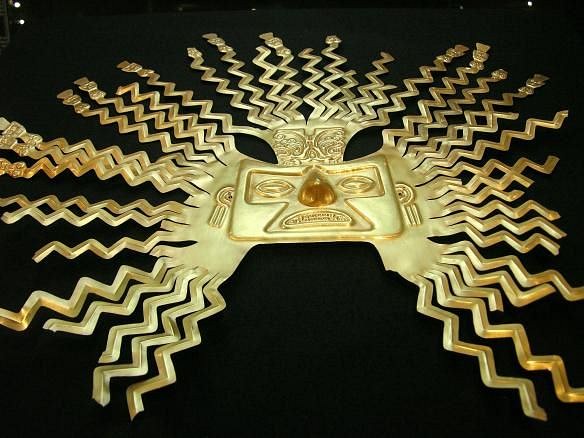
Inti was the Inca god of the sun and considered all-powerful but he was also a benevolent god and capable of great generosity. However, Inti could be angered and he would demonstrate his displeasure through solar eclipses which necessitated sacrifices to win back the god's good favour. Inca rulers considered themselves direct descendants of Inti, the patron of empire and military conquest.
INTI'S RELATIONS & ROLE
Inti was the sun, which in Inca mythology was created by the supreme Inca deity Viracocha from an island on Lake Titicaca. Although Viracocha was higher in status, he usually remained in the background of worldly affairs and allowed intermediaries such as Inti to actually govern the world. Inti was married to the goddess of the moon Quilla. Neatly linking the gods to mankind, the first Inca leader and founder of the civilization, Manoc Capac (previously called Ayar Manco) was believed either to have been instructed by Inti or actually been his son, along with the other original Inca ancestors such as Mama Coya (aka Mama Ocllo) who was also described as Inti's wife in some versions of the myth. In this way the successive Inca rulers could claim divine lineage and emphasise their role as intermediary between the gods and ordinary people. Manoc Capac even wore a sheet- gold costume to impress the populace with his divine parentage. However, it was not until Wiraqocha Inca (c. 1425 CE) or the 9th Inca ruler Pachacuti Inca Yupanqui (1438-1471 CE) that the cult of Inti really became established in the cultural practices of the Inca. With the expansion of the Inca empire sun worship was incorporated into the religions of the conquered peoples and used as an imperial propaganda that the Inca were the people with a divine right to rule.
THE CORICANCHA TEMPLE ('HOUSE OF THE SUN') AND SACSAHUAMAN SACRED PRECINCT AT THE INCA CAPITAL OF CUZCO WERE DEDICATED TO INTI.
THE CORICANCHA
The Coricancha temple ('House of the Sun') and Sacsahuaman sacred precinct at the Inca capital of Cuzco were dedicated to Inti and probably built in the reign of Pachacuti. It was here that the most senior figure in the Inca religion, the High Priest of the Sun ( Villac Umu ), presided over rites in honour of Inti, assisted by acllas (or acyllyaconas ) - young virgin priestesses.There were also sun ceremonies carried out by both male and female priests at sacred sites across the empire. Perhaps the most famous example is at Machu Picchu where a typical intihuatana or 'hitching post of the sun' situated at the highest point of the sacred precinct was used during the solstices to symbolically connect the sun to the earth using a special cord. The intihuatana were also used for regular astronomical observations of the sun and possibly other heavenly bodies. Other important temples were at Pisac (north-east of Cuzco), Ingapirca (in modern Ecuador), and on the Island of the Sun on Lake Titicaca which Inca rulers visited once a year in pilgrimage.
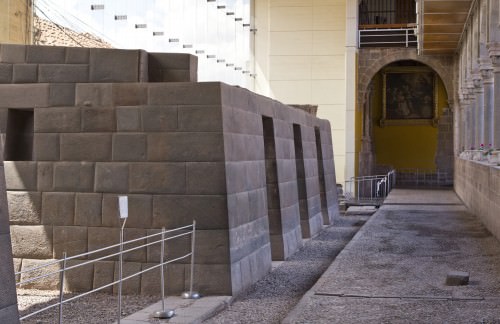
Coricancha
INTI RAYMI
Inti was especially worshipped during the festival of Inti Raymi held during the winter solstice in June and run over several days. One of the most common sacrifices to Inti was of white llamas but offerings of food, other livestock and even areas of farmland were also dedicated to the god. There were human sacrifices too (including child sacrifice) on special ceremonial occasions or in times of particular crisis such as earthquakes or a death in the royal family. Such ceremonies were designed to ensure the continued success of the Inca empire, its people and their harvests. One curious story is when an eagle was attacked by buzzards and fell from the skies during a ceremony in honour of Inti held in c. 1526 CE which was thought to foretell the collapse of the Inca empire. It was, indeed, around this time that the first signs of the deadly smallpox disease brought by the Spanish conquistadors from the Old World began to appear amongst the Inca population and it would be less than a decade before the Inca capital fell into Spanish hands.
REPRESENTATIONS IN ART
Inti was not often represented in Inca art but when he was it was usually as a gold statue, a sun disk or a golden mask. Gold was particularly associated with the god as it was believed that the precious metal was the sweat of the sun. The most sacred statue of Inti was kept in his shrine at Cuzco. The interior of this temple was a wonder in itself as it was lined with 700 half-metre panels of beaten gold whilst outside was a life-size scene of a field of corn with llamas and shepherds all made from gold and silver. The statue represented Inti as a small seated boy, called Punchao (Day or Midday Sun). From his head and shoulders the sun's rays shone, he wore a royal headband and had snakes and lions coming out of his body. The stomach of the statue was hollow and used to store the ashes of the vital organs of previous Inca rulers. Everyday this statue was brought out into the open air and returned to the shrine each night. The statue was taken to a place of safety when the Spanish arrived in the 1530s CE but it seems that they did eventually find it in 1572 CE but it disappeared without trace, probably melted down like so many other Inca artefacts.
The masks of Inti were typically made of thinly beaten gold and also had the sun's rays bursting from the god's head in a design common in pre-Inca deity masks. These rays were typically cut in a dramatic zig-zag fashion and sometimes ended in a small human face or figure. The most famous such mask was on display within the Coricancha temple at Cuzco.
The god's worshippers and the vast majority of the art made in his name have long since disappeared but Inti lives on in several present day South American cultures. The festival of Inti Raymi has been revived as a great yearly festival in Cuzco, several national flags bear an image of him in the form of a flaming sun, and the currency of Peru in the 1980s CE was called the inti and even now still references him with its new name sol - sun in Spanish.
Wari Civilization › Antique Origins
Definition and Origins
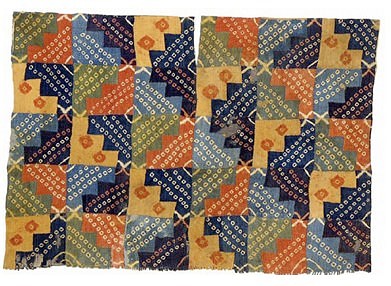
The Wari civilization flourished in the coastal and highland areas of ancient Peru between c. 450 and c. 1000 CE. Based at their capital Huari, the Wari successfully exploited the diverse landscapes they controlled to construct an empire administered by provincial capitals connected by a large road network. Their methods of maintaining an empire and artistic style would have a significant influence on the later Inca civilization.
The Wari were contemporary with those other great Middle Horizon (c. 600 - 1000 CE) cultures centred at Tiwanaku and Pukara. The more militaristic Wari were also gifted agriculturalists and they constructed canals to irrigate terraced fields. The economic stability and prosperity this brought allowed the Wari to implement a combined strategy of military might, economic benefits, and distinct artistic imagery to forge an empire across ancient Peru. Their superior management of the land also helped them resist the 30-year drought period which during the end of the 6th century CE contributed to the decline of the neighbouring Nazca and Moche civilizations.
The Wari were undoubtedly influenced by contemporary cultures, for example, appropriating the Chavin Staff deity -- a god closely associated with the sun, rain, and maize, all so vital to cultures dependent on agriculture and the whims of an unreliable climate. They transformed it into a ritual icon present on textiles and pottery, spreading their own branded iconography and leaving a lasting legacy in Andean art.
THE WARI IMPLEMENTED A COMBINED STRATEGY OF MILITARY MIGHT, ECONOMIC BENEFITS, AND DISTINCT ARTISTIC IMAGERY TO FORGE AN EMPIRE ACROSS ANCIENT PERU.
HUARI
The capital at Huari (25 km north of modern Ayacucho) is located at an altitude of 2,800 m and is spread over 15 square kilometres. It was first settled around 250 CE and eventually had a population possibly as high as 70,000 at its peak. Huari shows typical features of Andean architecture: densely packed wall -enclosed rectangular structures which can be further divided into a maze of compartments. The city 's walls are massive (up to 10 metres high and 4 metres thick) and built using largely unworked stones set with a mud mortar. Buildings had two or three stories, courtyards were lined with stone benches set in the walls, and drains were stone-lined. The floors and walls of buildings were generally covered with plaster and painted white.
There is little distinction in Wari architecture between public and private buildings and little evidence of town planning. A royal palace has, however, been identified in the northwest section of the city, its oldest area of habitation and called Vegachayoq Moqo. A now ruined temple was located in the Moraduchayuq compound in the southeast of the city. It was built in the 6th century CE and had subterranean parts with the whole structure once painted red. Like other buildings at the site it was deliberately destroyed and ritually buried. The city seems to have been abandoned c. 800 CE for reasons unknown.
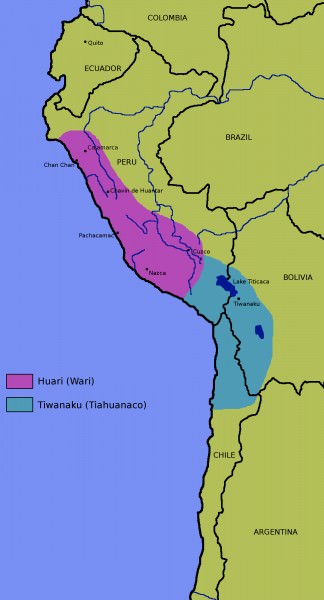
The Wari Empire
Tombs have been excavated at Huari which contained fine examples of Wari textiles. Ceramics are also amongst finds at the site. A royal tomb was discovered in the Monjachayoq zone which consists of 25 chambers on two different levels, all lined with finely cut stone slabs. In addition, a shaft descends to a third level chamber which has the shape of a llama. Finally, a circle chamber was cut out at a fourth level down. The llama-shaped tomb, looted in antiquity, was the royal resting place and dates to 750-800 CE.
Huari was once surrounded by irrigated fields and fresh water ran through the city via underground conduits. Further indicators of prosperity are the presence of areas dedicated to the production of specific goods such as ceramics and jewellery. Precious materials for these workshops and imported goods indicate trade with far-flung places: shells from the coast and Spondylus from Ecuador, for example. The presence of buildings used for storage at Huari and other Wari cities also indicates a centrally controlled trade network spread across ancient Peru.
PIKILLACTA
Another important Wari centre was at Pikillacta, southeast of Huari which was founded c. 650 CE. Located at an altitude of 3250 m, the heart of this administrative and military settlement site was built in a rectangular form measuring 745 x 630 metres and is laid out in a precise geometrical pattern of squares. The interiors of individual compounds are, however, idiosyncratic in layout.
As at other Wari sites, access was strictly controlled via a single, winding entrance. Notable finds at Pikillacta include 40 miniature greenstone figures depicting elite citizens and small figurines (no larger than 5 cm) of transformational shamans, warriors, bound captives, and pumas in copper, gold, and semi-precious stone. The site was abandoned c. 850 - 900 CE and there is evidence of destruction by fire of some buildings and deliberately sealed doorways.
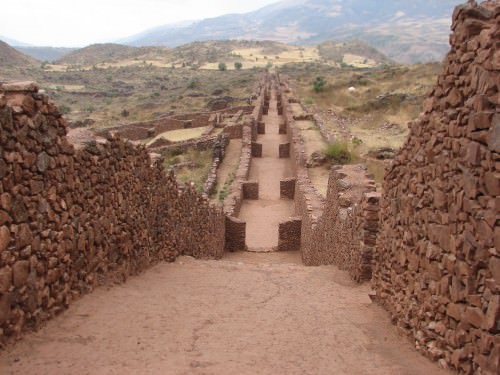
Pikillacta
Other important Wari cities were Viracochapampa, Jincamocco, Conchopata, Marca Huamachuco, and Azangaro. There were also purely military sites such as the fort at Cero Baul, which bordered on Tiwanaku territory to the south. These sites were connected to water sources and each other by a system of roads.
WARI ART
Wari art is best evidenced in textile finds which often depict the Staff Deity, plants, the San Pedro cactus flower, pumas, condors, and especially llamas, illustrating the importance of these herd animals to the Wari. Textiles were buried with the dead and those tombs in the dry dessert have been well-preserved. Textiles were multi-coloured, although blue was particularly favoured, and designs were composed of predominantly rectilinear geometric forms, especially the stepped diamond motif. At the same time, despite seemingly regular geometric patterns, weavers often introduced a single random motif or colour change (typically using green or indigo) into their pieces. These could be signatures or an illustration that rules could always have exceptions.
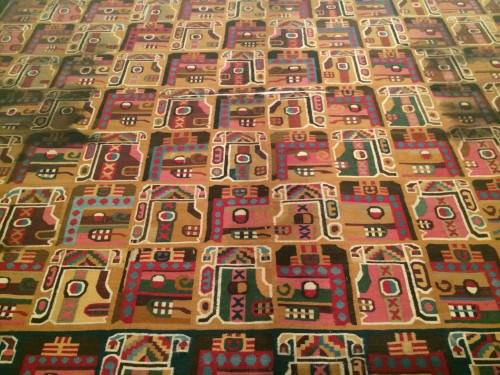
Wari Tapestry Panel
Wari designs eventually became so abstract that figures were essentially unrecognisable, perhaps in a deliberate attempt by the elite to monopolize their interpretation. Abstract figures distorted almost beyond recognition may also be an attempt to represent the shamanic transformation and drug-induced trance consciousness which were part of Wari religious ceremonies.
Popular Wari pottery forms were the double-spouted vessels seen elsewhere in Andean cultures, large urns, beakers, bowls, and moulded effigy figures. Decorative designs were heavily influenced by those used in Wari textile production. The Staff Deity was an especially popular subject for beakers ( kero ) as were warriors with dart throwers, shields, and military tunics.
Precious metals were also a popular medium for elite goods. Notable finds from a royal tomb at Espiritu Pampa include a silver face mask and breast-plate, gold bracelets, and other jewellery in semi-precious stones such as greenstone and lapis lazuli. Human figures in typical Wari costume - sleeveless tunic and four-cornered hat - were also made in hammered precious metals.
THE WARI LEGACY
Although the exact causes of Wari decline are not known, theories range from over-extension of the empire to another period of extended drought in the 9th century CE. Whatever the reasons, the region returned to a situation of fragmented polities for several centuries.
The most lasting legacy of the Wari is their artistic style which not only influenced the contemporary Moche but also the later Lambayeque civilization, and later still, the Incas. A large number of the roads built by the Wari were also used by the Incas within their own extensive road system, as were a great number of Wari terraces for agriculture. The capital at Huari was looted in antiquity and again in the 16th century CE by the Spanish.
Re-discovered in the mid-20th century CE, the first excavations began in the 1940's and continue today, gradually revealing the wealth and power once enjoyed by one of the most important of all ancient Andean cultures.
MAP
LICENSE:
Article based on information obtained from these sources:with permission from the Website Ancient History Encyclopedia
Content is available under License Creative Commons: Attribution-NonCommercial-ShareAlike 3.0 Unported. CC-BY-NC-SA License